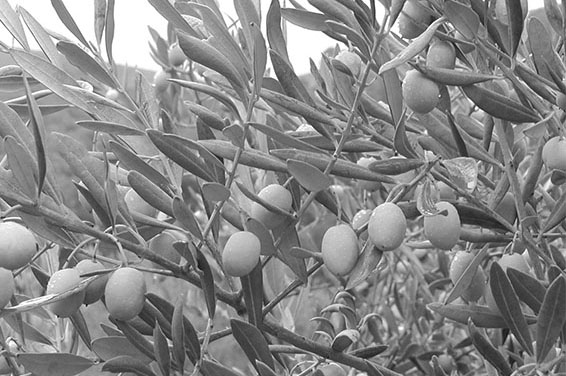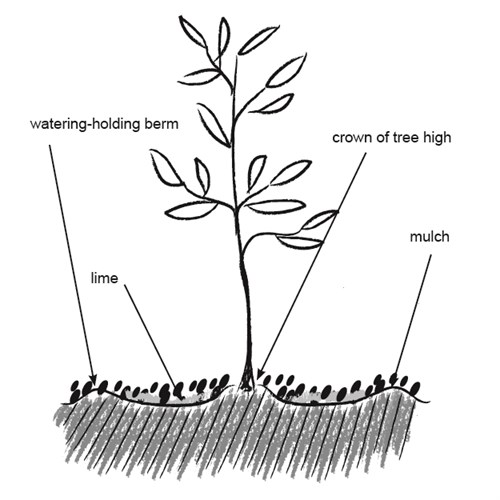



Planting Olive Trees
These recommendations are intended as a guide only. Soil types and climate vary and must be taken into consideration on a specific site basis. We support and encourage sustainable growing practices.
Climate
Extreme cold is not compatible with olive production. Although olives do require some chilling for fruit set—about 200 hours of winter temperatures below 45º F—the University of California guidelines state that temperatures below 22º F can kill young trees and cause branch die back on older trees. Mature trees are said to be at risk at temperatures below 15º F.
There are many variables in cold tolerance, including the olive variety, the severity of temperature fluctuations and how much water the tree has in its tissues. Microclimates can also be critical when temperatures are low, so avoid frost pockets and stagnant areas. Cold temperatures, or extremely hot and windy conditions, during bloom in April or May can also be a problem, causing poor fruit set. In the Fall and Winter before harvest, temperatures below about 29º F will freeze the fruit and cause defective flavors in olive oil.
Soil
Olive trees can thrive in a fairly wide variety of soil conditions with one important exception: they are completely intolerant of poor drainage. Waterlogged soil probably causes the death of more olive trees than anything else. Soils with a moderately high clay content are not completely off limits, but you must improve drainage by planting on a hillside or on a berm. A soil test will reveal any nutrient deficiencies or toxicities in a particular location. Olive oil production does not benefit from first-rate soil; modest fertility will produce the best olive oil. One other important issue when selecting a site is the cropping history of the location. Olive trees are susceptible to verticillium wilt. If the field has been planted in tomatoes, cotton, peppers or any other verticillium susceptible crop, the soil should be tested for the presence of this pathogen.
Water
Newly planted olive trees will do best if they are well watered. Even though olives are famously drought tolerant when established, they will be more attractive and productive if they receive regular, deep watering–especially when young. Your soil type will have a big impact on water needs, so monitor your irrigation carefully; you want to give the trees adequate water but it is critical to avoid “wet feet.” When the trees are first planted, be sure to place a drip emitter close to the trunk so that the root ball of the tree is being watered. As the tree grows, however, you want to move the drip emitters away from the trunk to encourage the roots to spread. The majority of any tree’s roots are at the drip line of the canopy, so don’t crowd the emitters close to the trunk.
Pruning and training
In general, olive trees should not be pruned much for the first four or five years. The more foliage an olive tree has, the more energy it produces, so you don’t want to remove growth when the tree is getting established. The primary objective in the early pruning is training the olive tree to a single trunk if desired. To do this, remove suckers and large branches that develop below about three feet on the trunk. It is not necessary to strip the lower trunk completely during the first few years, but cut back any substantial branches to eight inches so that they don’t compete with the main trunk. At four or five years you can do the first major pruning to open up the center of the tree and create a good scaffold.

Planting
Dig a hole that is one-and-a-half to two times the diameter of the container. Pay close attention to the soil level when you plant an olive tree; you want the final soil level of the planted tree to be at the same place as the ground level was in the container. Don’t dig the hole too deep or you can have problems with the tree sinking—this allows water to pool around the crown of the tree and can cause disease problems. Plant the tree a little bit high to allow for settling.
Weed management
Controlling competition from weeds will make a big difference for your newly planted olive trees. There are many ways to manage weeds, but be sure to do it. One of the easiest and most attractive options is a thick layer of organic mulch around the tree. Keep mulch a few inches away from the tree trunk to avoid trapping moisture at the crown. Poor weed management will stunt the growth of your trees.
We recommend:
1. Use of sea kelp products, specifically liquid extracts of Ascophillum nodosum.
When the first irrigation after transplanting is made with a 1:500 solution of liquid kelp, the transplant shock will be greatly diminished and the trees will receive an excellent dose of a wide range of micronutrients contained in the kelp.
If you anticipate temperatures low enough to cause tree damage, an irrigation and/or a foliar application of liquid kelp solution is recommended. An abundance of potassium ions and other elements in the plant tissue will increase the plant’s resistance to freezing at threshold temperatures.
2. Use of organic mulches to reduce soil moisture evaporation and enhance soil biological activity.
A three to five inch layer of these materials applied under the trees will significantly reduce water evaporation from the soil’s surface, suppress germination of weed seeds, and will slowly decay, providing a source of carbon—food for microorganisms in the soil. Since olive trees thrive on free calcium, applications of lime (mined lime, oyster shell lime, dolomite, or gypsum depending on soil needs). The lime should be sprinkled under the trees at the label rate and then covered with the organic mulch. Mycronized or very finely ground rock (basalt, granite, other igneous rock) can be used in the same manner.